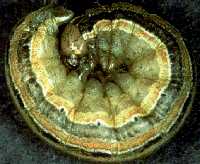by F.B. Peairs 1(12/14)
Quick Facts…
- The armyworm cannot survive Colorado winters. Armyworm moths migrate into Colorado in early summer.
- Larvae feed at night and on cloudy days and hide under crop debris during sunny periods.
- Armyworms have five stripes, three on the back and two on the sides, running the length of the body.
- In Colorado, it is mostly a pest of corn and spring grains, with only occasional infestations in winter wheat.
- Outbreaks are sporadic and unpredictable, so management options are limited to the use of insecticides.
 |
Field Biology
The armyworm cannot survive Colorado winters. Instead, armyworm moths migrate into Colorado in early summer. They lay their eggs in rows or clusters on the lower leaves of various grass crops. Dense grassy vegetation is preferred for oviposition. Newly hatched larvae move with a looping (inchworm) action. Larvae feed at night and on cloudy days, and hide under crop debris during sunny periods. One or more generations may occur per year.
Mature larvae are about 1.5 inches long, smooth-bodied, and dark grey to greenish-black. They have five stripes, three on the back and two on the sides, running the length of the body. While the stripes on the back vary in color, the stripes on the sides are pale orange with a white outline. The head capsule is remarkable for its
“honeycomb” of black markings.
Host Plants
Armyworm feeding is limited mostly to grasses, although this insect will feed on a number of other plants when starved. In Colorado, armyworm is mostly a pest of corn and spring grains, with only occasional infestations occuring in winter wheat.
Distribution
Armyworm is found east of the Rockies in the United States and Canada and occurs in most agricultural areas in Colorado and in the San Luis Valley.
Best Management Practices
Armyworm outbreaks occur only occasionally because they have many natural enemies that usually prevent the development of economically significant infestations. Because of the sporadic and unpredictable nature of armyworm outbreaks, management options are limited to insecticides. Scout for armyworm in field margins, low areas with rank growth, or areas of lodged plants. Look for feeding damage, frass (droppings) around base of plant, or plant material that has been around damaged plants and in heads of barley or wheat.
Consider treating armyworm infestations if all of the following conditions are met:
- larval counts exceed the appropriate level in Table 1;
- worms are 0.75 to 1.25 inches long;
- most larvae are not parasitized (look for white eggs behind the head or small brown cocoons attached to the body); and
- leaf feeding or head clipping is evident.
| Table 1: Action thresholds for the true armyworm in field corn and small grains. | |
| Situation | Action Threshold |
|---|---|
| Field corn | Lower 1/3 of leaves consumed before hard dent stage. |
| Small grains (preheading – defoliation in lower leaves) | 5 larvae per square foot |
| Small grains (head clipping) | 2 larvae per square foot |
Insecticides labeled for the control of this pest can be found in the most recent version of the High Plains Integrated Pest Management Guide for Colorado, Montana, Western Nebraska and Wyoming, which is available at https://wiki.bugwood.org/HPIPM:Main_Page.
*Colorado State University Extension entomologist and professor, bioagricultural sciences and pest management. 9/99. Revised 12/14.
Colorado State University, U.S. Department of Agriculture and Colorado counties cooperating. Extension programs are available to all without discrimination. No endorsement of products mentioned is intended nor is criticism implied of products not mentioned.
Go to top of this page.





